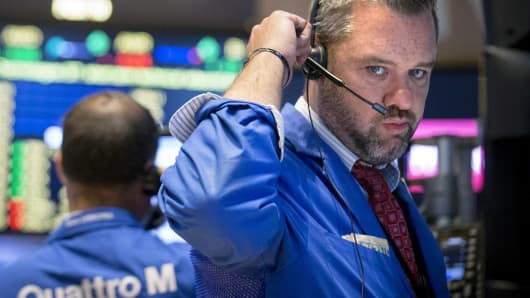At the depths of the Great Financial Crisis, the U.S. Federal Reserve arrested the market rout by introducing quantitative easing to explicitly support asset prices. That plan worked for over six years — but now it's failing.
The U.S. stock market (as measured by the S&P 500) climbed over 200 percent from its lows in March 2009 to its peak this year. The primary driver of this move was the perception that central banks can support asset prices — this perception was tested repeatedly until it became market reality. Markets cajoled not only the Fed into supporting asset prices, but also the European Central Bank, the Bank of Japan and the People's Bank of China. Each market selloff was met with more central bank support and the primary driver of higher asset prices was reinforced.
Read MoreGet ready: Looks like a bloody Monday
The secondary driver of the stock market reality was the perception that higher asset prices would create economic growth. More specifically, investors have been betting that higher asset prices would create economic growth strong enough to withstand the removal of central bank support. This has been dubbed "escape velocity." Unfortunately, the U.S. and global economy have failed to reach escape velocity and markets are in the nasty process of withdrawal.
What caused the global market rout?
Two words: Oil and China. While many have dismissed the decline in oil prices as nothing more than a supply glut, my view has been that oil was signaling a global economic slowdown.
Energy is the economy — nothing is produced, shipped, sold or consumed without energy. This is precisely why oil is the most widely traded commodity in the world and why falling oil prices are a signal of a slowing economy. The supply glut in oil was a signal of overcapacity in the global economy — the Chinese economic miracle caused a tremendous buildup in commodity production. There is not just overcapacity in oil, but also in steel, copper, iron ore, and shipping to name a few. In order to correct this overcapacity, the global economy must recede - this is the exact function of a recession - to align supply with demand.
At the same time that oil was signaling a slower global economy, China was attempting to rebalance its export-focused economic growth and pop several bubbles in its economy. The long-run plan for the Chinese economy is a shift from export powerhouse to a nation of consumers. This plan will not only take years to complete but the adjustment process is likely to be quite bumpy.
Read MoreAmid the carnage, strategists predict bounce; 'go all in'
In the short term, China has attempted to pop a credit-driven real-estate bubble. In an effort to soften the blow of falling real-estate prices, the Chinese government encouraged stock market speculation — this inevitably caused a stock-market bubble. When the Chinese stock-market bubble burst in June, investors lost confidence that the government could support asset prices. In other words, investors lost confidence in the People's Bank of China put.
Where do we go from here?
The typical post-crisis response to a global market rout has been more central bank support — however, given the loss of confidence in central-bank activism, further support may not work. The Chinese have lost control of the stock market; despite arresting short sellers (those who bet that stocks will fall), forbidding large institutions to sell and halting trading of a majority of the stocks, the Chinese stock market continues to fall. Additionally, the U.S. Federal Reserve is trapped. The U.S. economy is not strong enough to warrant a rate increase, but it's not weak enough to constitute another round of "emergency" quantitative easing (QE4). This leaves only the European Central Bank and the Bank of Japan in a position to "ride to the rescue."
Read MoreApple plunges 5%, breaks below $100
Unfortunately, the Bank of Japan's credibility has been severally eroded by an economy that has failed to grow despite aggressive monetary easing. This leaves Mario Draghi and the European Central Bank as the only institution capable of arresting the market selloff. In my view, further action from the European Central Bank is probably enough to temporarily halt a market slide, but not enough to make a permanent difference.
Given this reality, caution is the most prudent stance to assume on any central bank driven market rally. Investors would be wise to use any central bank driven market rally to re-evaluate portfolio composition. There will be plenty of opportunities to make money in this new market paradigm, but it will take more than the one brain cell it has required over the last six years.
Brian Kelly is founder and managing member of Brian Kelly Capital LLC, a global macro investment firm catering to high net worth individuals, family offices and institutions. He is also the creator of the BKCM Indexes, benchmarks for multi-asset money managers. He's also the author of the upcoming book, "The Bitcoin Big Bang: How Alternative Currencies Are About to Change the World." Kelly, a CNBC contributor, often appears on "Fast Money." Follow him on Twitter @BKBrianKelly.



